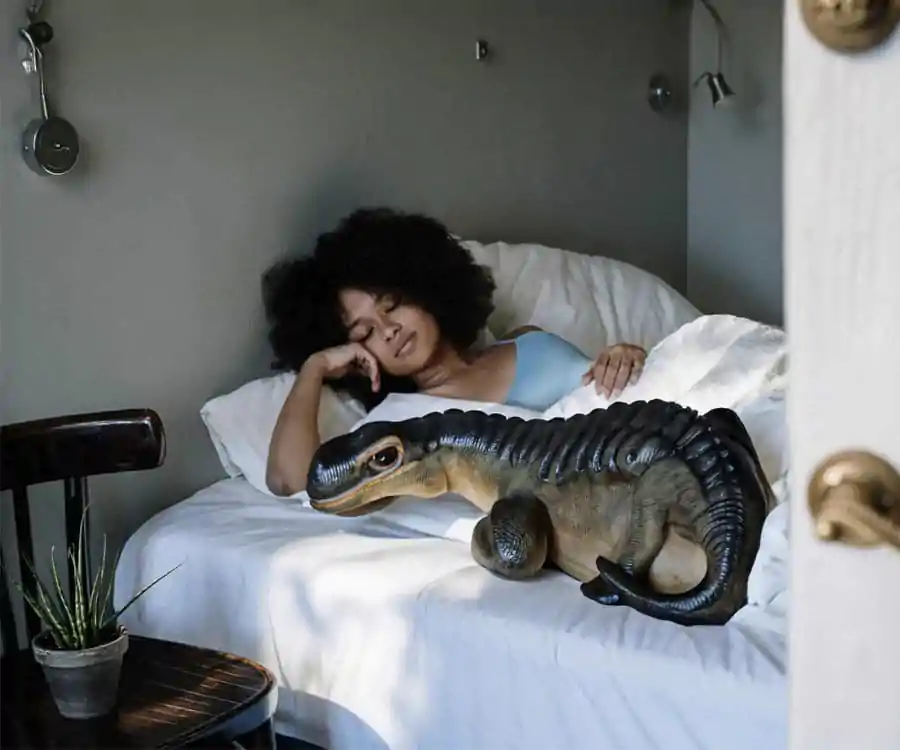Welcome to the exciting world of dinosaur hands and their sleeping positions. Have you ever wondered how these ancient creatures rested at night? Or why studying their behavior is so important for understanding animal adaptations? You’re in luck because we’ve got all the answers right here.
From the diversity of hand structures to notable examples of unique adaptations, we’ll explore it all.
An Overview of Dinosaur Hands Sleeping Patterns
Dinosaur hands were remarkably diverse, ranging from the massive claws of theropods to the delicate digits of ornithischians. Despite their differences, many dinosaur hands shared common traits that allowed them to perform a variety of tasks.
One important aspect of studying dinosaur behavior is understanding how they rested and slept. Fossil evidence suggests that some dinosaurs may have slept standing up like modern birds, while others likely hunkered down on the ground.
Interestingly, scientists can infer a lot about dinosaur sleeping positions based on their anatomy. For example, sauropods had relatively short forelimbs compared to their hind limbs, which would have made it difficult for them to sleep upright.
In contrast, species such as Stegosaurus had broad feet with large surface areas that could support their weight while lying down. These adaptations provide valuable insights into how different types of dinosaurs lived and interacted with their environment.
Analyzing dinosaur hand structures and sleeping habits helps us better understand these fascinating creatures and the world they inhabited millions of years ago.
Why It Is Important To Study Animal Behavior and Dinosaur Hands Sleeping Position
Studying animal behavior, including dinosaur hand-sleeping positions, provides us with valuable insights into the evolution of species and their adaptations to changing environments. By understanding how dinosaurs slept and relaxed, we can gain an understanding of their lifestyle and ecological niche.
Through studying dinosaur behaviors such as sleeping positions, we can also observe patterns that may be applicable to modern-day animals. For example, some scientists believe that certain types of dinosaur slept in groups for protection against predators at night – a behavior observable in many modern bird species.
Furthermore, examining dinosaur hand structures and functions in relation to sleep posture can provide clues about how they interacted with their environment. Did they use their hands for balance or support while resting? Did they keep them tucked under their body or outstretched?
By answering these questions through careful study of fossil evidence and comparative analysis with living animals, we can begin to piece together a clearer picture of life on earth millions of years ago.
Studying animal behavior is important not only for our scientific curiosity but also for gaining insights into the natural world around us.
Diversity of Dinosaur Hand Structure and Functions
Dinosaurs have been extinct for millions of years, but their fossils continue to fascinate us. One aspect that scientists find intriguing is the diversity of dinosaur hand structure and functions. Just like human hands, dinosaur hands were adapted to perform various tasks.
Some dinosaurs had small, delicate hands with long fingers suited for grasping insects or picking berries. Others had large, robust claws ideal for hunting prey or defending against predators. Interestingly, some dinosaurs even had specialized thumbs that could pivot in a way similar to our own opposable thumbs.
Furthermore, the shape and size of dinosaur hands varied greatly between species. Some dinosaurs had elongated metacarpals which allowed them to run on two legs more efficiently while others used their broad palms for stability when walking on all fours.
While studying these differences may seem trivial at first glance, it provides insight into how dinosaurs lived and evolved over time. By understanding the unique adaptations of each species’ hand structure and function we can piece together an image of what life was like during the Mesozoic era.

Notable Examples of Dinosaur With Unique Hand Adaptations
Dinosaurs were a diverse group of animals that lived millions of years ago. They had many unique features, including their hands, which varied in size and function depending on the species. Some dinosaurs had small hands with sharp claws for hunting prey, while others had large hands with blunt claws for digging or grabbing vegetation.
One example of a dinosaur with unique hand adaptations is the Therizinosaurus. This dinosaur had long arms and curved claws that it likely used to grab leaves from tall trees. Another interesting example is the Spinosaurus, which had elongated fingers that may have been used to catch fish in rivers.
The Velociraptor also had remarkable hand adaptations; its famous sickle-shaped claw was used for slashing at prey during hunts. The Oviraptor’s shorter fingers were covered in feathers and are thought to have been used for brooding eggs.
Types of Dinosaur Sleeping Positions
Dinosaurs, like most animals, had various sleeping positions that they adopted depending on the circumstances. Some slept standing up while others preferred to lie down. The types of dinosaur sleeping positions can vary widely based on factors such as size, weight and body structure.
One common position is the “crouched” position where the dinosaur would bend its legs and curl its tail around itself for warmth and protection. This posture was often used by smaller dinosaurs who were vulnerable to predators in their sleep.
Another position is referred to as the “prone” position where a dinosaur would lay flat on its stomach with its limbs extended outward from the body. This stance was more commonly seen amongst larger herbivorous species as it allowed them to rest their massive bodies without putting too much pressure on any one point.
Some dinosaurs even chose to sleep perched high atop tree branches using their strong claws for grip and balance while others still preferred sleeping in burrows or dens dug into hillsides or underground.
There were many different types of dinosaur sleeping positions each with unique benefits, drawbacks, and purposes – just like modern-day animals today!
Factors Influencing Dinosaur Sleeping Positions
Dinosaurs, just like any other animal species, had their own unique sleeping positions. These positions were influenced by various factors such as the dinosaur’s size, environment, and behavior.
The size of a dinosaur played a significant role in determining its sleeping position. Larger dinosaurs often slept upright or leaning against trees to support their weight while smaller dinosaurs could sleep curled up on the ground.
The environment where a dinosaur lived also influenced its sleeping habits. Dinosaurs that lived in open areas with predators around were more likely to sleep standing up so they could quickly escape if needed. Dinosaurs that lived in dens or burrows would curl up for warmth and protection from predators.
Another factor influencing dinosaur sleeping positions was behavior. Some dinosaurs may have slept alone while others preferred to sleep in groups for safety and companionship.
Interestingly, recent studies suggest that some dinosaurs may have entered REM (rapid eye movement) sleep which is associated with dreaming and processing memories, similar to modern-day birds and mammals.
Understanding the factors influencing dinosaur sleeping positions can give us valuable insights into how these ancient creatures lived and adapted to their environments.
Controversies and Debates
Controversies and debates surrounding dinosaur sleeping positions have been a topic of discussion among paleontologists for many years. One of the most debated issues is whether dinosaurs slept standing up or lying down. Some believe that larger dinosaurs such as sauropods were too heavy to lie down, while others argue that they must have laid down at some point in order to rest properly.
Another controversy is whether some dinosaurs had the ability to sleep with one eye open, similar to modern-day birds. This theory is based on studies of fossilized skulls which show a small opening in the skull called the pineal gland, which is present in birds and other animals that are capable of unihemispheric sleep.
There has also been debate over whether certain types of dinosaurs were nocturnal or diurnal animals. While some experts believe that all dinosaurs were active during the day, others argue that certain species may have been more active at night in order to avoid predators or conserve energy during hot weather.
Despite these controversies and debates surrounding dinosaur sleeping behavior, it remains an interesting area of study for researchers looking to gain insights into these ancient creatures’ behavior and physiology.
Insights into Dinosaur Behavior and Physiology
Through studying the sleeping positions of dinosaurs, there have been several insights into their behavior and physiology. For instance, it has been observed that some dinosaur species slept in groups or herds for protection against predators while others might have preferred solitary sleep to avoid bad mental health days.
Moreover, the study of dinosaur hand structure and function has given us an idea of how they used them to achieve different tasks such as hunting, grasping food or climbing trees. Additionally, it is believed that some dinosaur species had specialized palms with large quills or padding which could be used for a variety of purposes such as digging burrows for nesting.
Furthermore, examining factors that influenced the sleeping position adopted by various dinosaur species gives us insight into their environment and social behavior. Some scientists believe that temperature regulation may have played a role in determining where certain dinosaurs slept while others suggest social dynamics within a group could influence positioning.
These insights not only help us understand more about these fascinating prehistoric creatures but also allow us to make connections between modern-day animal behavior and our own evolutionary history.
Tips for studying Dinosaur Hands Sleeping Position
- Start by digging into information about the specific dinosaur types you’re curious about. Their body structure and habits will shape how they might have rested their hands.
- Check out fossils that show dinosaur remains in different positions. These ancient clues can help you figure out how their hands were likely positioned during sleep.
- Observe animals today that are similar to dinosaurs, like birds and reptiles. How they sleep might give you hints about how dinosaurs might have done it.
- Chat with palaeontologists and other experts who spend time studying dinosaurs. They can share their knowledge and ideas with you.
- Study the bones of dinosaurs to see how their joints and bones were built. This can give you insights into how their hands could move.
- Consider how different types of dinosaurs acted. Did they need a specific pose to rest comfortably or protect themselves? This can guide your ideas.
- When the evidence is missing, let your creativity flow. Combine what you know with logical guesses to create reasonable pictures of how they slept.
Conclusion
From studying dinosaur hand structure and sleeping positions, we have gained a deeper understanding of their behavior and physiology. We have seen the diversity in adaptations that allowed these prehistoric creatures to survive and thrive. The controversies and debates surrounding this topic only add to the intrigue of these fascinating animals.
As we continue to learn more about dinosaurs through scientific discoveries, it is important to remember the importance of studying animal behavior in general. By understanding how animals interact with their environment, we can better protect them from threats such as habitat destruction or climate change.
Learning about dinosaur hands and sleeping positions not only provides us with valuable insights into ancient species but also highlights the importance of protecting modern-day biodiversity for future generations.
FAQs About Dinosaur Hands Sleeping Position
Q1: What were the common traits among dinosaur hands despite their diverse structures?
A1: Dinosaur hands varied widely, but many shared common traits that allowed them to perform various tasks. These traits offer insights into their behaviors and adaptations.
Q2: How did sauropods and Stegosaurus demonstrate different sleeping positions based on their anatomy?
A2: Sauropods, with short forelimbs, likely found it challenging to sleep upright, while Stegosaurus, with broad feet, could support their weight while lying down. Anatomy provided clues to their sleeping habits.
Q3: Why is studying dinosaur sleeping positions important for understanding animal adaptations?
A3: Understanding how dinosaurs slept provides valuable insights into their lifestyles and ecological niches, aiding in comprehending their adaptations to changing environments over millions of years.
Q4:What insights can be gained by studying dinosaur behaviors, including sleeping positions, applicable to modern-day animals?
A4: Observing patterns in dinosaur behaviors may offer insights applicable to modern animals. For example, some dinosaurs may have slept in groups for protection, similar to certain modern bird species.
Q5: What are some examples of unique hand adaptations in dinosaurs, and how did these adaptations serve specific purposes?
A5: Therizinosaurus, Spinosaurus, Velociraptor, and Oviraptor are examples of dinosaurs with unique hand adaptations. Each adaptation served a specific purpose, such as grasping leaves, catching fish, or slashing at prey.


